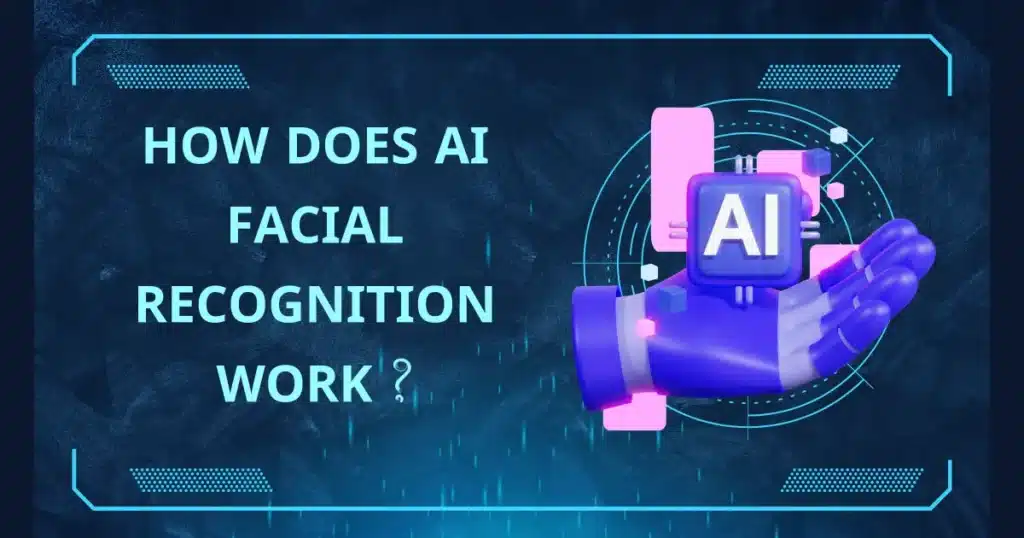Table of contents

Introduction:
AI facial recognition has rapidly become one of the most discussed and utilized technologies in recent years. Its applications span across various industries, from security and law enforcement to retail and social media. But how does AI facial recognition work, and why is it becoming so integral to our daily lives? In this article, we’ll delve into the intricacies of AI facial recognition, exploring the technology behind it, its applications, and the role of companies like Indo AI and DutyPar in advancing this technology.
Understanding the AI Facial Recognition:
AI facial recognition is a technology that identifies and verifies human faces from images or videos. It operates by analyzing facial features and comparing them to a database of known faces. The process may seem simple, but it involves a complex interplay of various AI techniques and algorithms.
1. Image Acquisition: The First Step
The process of AI facial recognition begins with image acquisition. Cameras capture images or videos of faces, which serve as the raw data for the system. The quality and angle of these images are crucial, as they directly affect the accuracy of the recognition process. High-resolution images with clear, front-facing views yield the best results, though modern AI systems are increasingly capable of handling variations in lighting, angle, and even partial obstructions.
2. Face Detection: Isolating the Face
Once the image is acquired, the next step is face detection. In this stage, the AI system scans the image to locate the presence of a face. This is usually done using Haar Cascades or more sophisticated methods like Convolutional Neural Networks (CNNs). CNNs, in particular, have revolutionized face detection by enabling the system to recognize faces with high accuracy even in challenging conditions.
3. Feature Extraction: The Heart of the Process
After detecting the face, the system proceeds to feature extraction. This involves identifying key facial landmarks such as the eyes, nose, mouth, and the overall shape of the face. These features are then converted into a numerical representation, often referred to as a faceprint or face vector. The faceprint is a unique mathematical model that represents the distinct features of a person’s face.
4. Face Matching: Comparing with Known Faces
The extracted features are then compared against a database of known faces. This is where the real power of AI comes into play. Machine learning algorithms compare the faceprint of the captured image with the stored faceprints in the database. If they find a match, the system identifies the person with a high degree of accuracy. This process resembles fingerprint matching, but instead of fingerprints, it matches facial features.
5. Decision Making: The Final Verdict
Based on the face matching results, the system makes a decision. This could involve identifying a person in a crowd, granting access to a secure area, or even triggering an alert in case of a mismatch. The accuracy of this decision depends on the quality of the image, the sophistication of the AI model, and the size of the database.
6. Learning and Adaptation: Continuous Improvement
AI facial recognition systems are not static; they learn and adapt over time. As they process more images and encounter more faces, they refine their algorithms, improving accuracy and reducing the likelihood of errors. This continuous learning process is a hallmark of modern AI systems and is critical for handling changes in appearance, such as aging or facial hair.
Applications of AI Facial Recognition:

People are using AI facial recognition in a wide range of applications today, making it more than just a theoretical concept. Here are some of the most prominent uses:
1. Security and Law Enforcement
Perhaps the most well-known application of AI facial recognition is in security and law enforcement. The technology is used to identify criminals, track suspects, and even prevent fraud. Airports, for example, use facial recognition to verify the identity of passengers, enhancing security while reducing the need for manual checks.
2. Retail and Marketing
In the retail sector, people use AI Facial Recognition to create personalized shopping experiences. Stores equipped with facial recognition cameras can identify returning customers, track their preferences, and offer tailored promotions. This not only improves customer satisfaction but also boosts sales.
3. Healthcare
In healthcare, professionals use facial recognition for patient identification and monitoring. Hospitals verify patients’ identities with this technology to ensure they receive the correct treatments. Additionally, they use facial recognition to monitor patients’ emotional states, gaining valuable insights into their well-being.
4. Social Media and Photography
Social media platforms like Facebook and Google Photos use facial recognition to tag people in photos automatically. This makes it easier to organize and share images, enhancing the user experience. However, people have raised privacy concerns because users may not always consent to being tagged or identified in photos.
The Role of Indo AI and DutyPar in AI Facial Recognition:
Companies like Indo AI and DutyPar are at the forefront of developing AI facial recognition technology. Their contributions have been instrumental in advancing the field, making it more accessible and reliable for various applications.
Indo AI: Pioneering Facial Recognition in Security
Indo AI has been a pioneer in developing facial recognition systems for security purposes. Their technology is used in various sectors, from government agencies to private enterprises. Indo AI’s facial recognition solutions are known for their accuracy and speed, making them ideal for real-time applications such as surveillance and access control.
One of the key innovations from Indo AI is their use of deep learning algorithms to enhance the accuracy of facial recognition. By continuously training their models on large datasets, they have achieved a level of precision that sets them apart from competitors. Their systems can recognize faces even in challenging conditions, such as low light or extreme angles, making them highly reliable for security applications.
DutyPar: Revolutionizing Attendance and Verification
DutyPar has focused on using facial recognition for attendance and verification systems. Their solutions are widely used in educational institutions, corporate offices, and even remote work setups. By leveraging AI facial recognition, DutyPar has simplified the process of tracking attendance, making it more efficient and less prone to errors.
DutyPar’s technology is particularly notable for its ease of integration. Whether it’s a small business or a large enterprise, their facial recognition systems can be seamlessly integrated into existing workflows. This flexibility has made DutyPar a popular choice for organizations looking to adopt AI facial recognition without overhauling their current systems.
The Future of AI Facial Recognition
As AI technology continues to evolve, so too will facial recognition systems. We can expect to see improvements in accuracy, speed, and the ability to handle more complex scenarios. Additionally, advancements in edge computing may enable facial recognition to be performed on devices rather than relying on cloud servers, enhancing privacy and reducing latency.
The role of companies like Indo AI and DutyPar will be crucial in shaping the future of AI facial recognition. By continuing to innovate and address the ethical challenges, they will help ensure that facial recognition technology is used responsibly and effectively.
Conclusion
So, how does AI facial recognition work? It’s a complex process that involves multiple steps, from image acquisition and face detection to feature extraction and face matching. Despite the challenges, AI facial recognition has proven to be a valuable tool in various sectors, including security, retail, healthcare, and more. With companies like Indo AI and DutyPar leading the charge, we can expect to see even more advancements in this technology, making it an integral part of our daily lives. As we move forward, it’s essential to balance innovation with ethical considerations to ensure that AI facial recognition is used for the greater good.
AI facial recognition is a technology that identifies or verifies individuals by analyzing and comparing facial features from images or videos. It uses advanced algorithms and machine learning techniques to recognize faces with high accuracy.
AI facial recognition works through a series of steps, including image acquisition, face detection, feature extraction, face matching, and decision making. The system captures an image, detects the face, extracts unique facial features, compares them with a database of known faces, and then determines if there’s a match.
Challenges include privacy concerns, the potential for bias in the algorithms, and the ethical implications of surveillance. There are also technical challenges like dealing with variations in lighting, angles, and partial obstructions.
The accuracy of AI facial recognition can be very high, especially when using advanced deep learning algorithms and high-quality images. However, accuracy can vary depending on the conditions (e.g., lighting, angle) and the diversity of the training data used.





